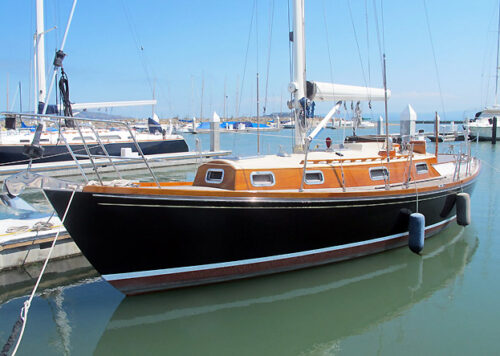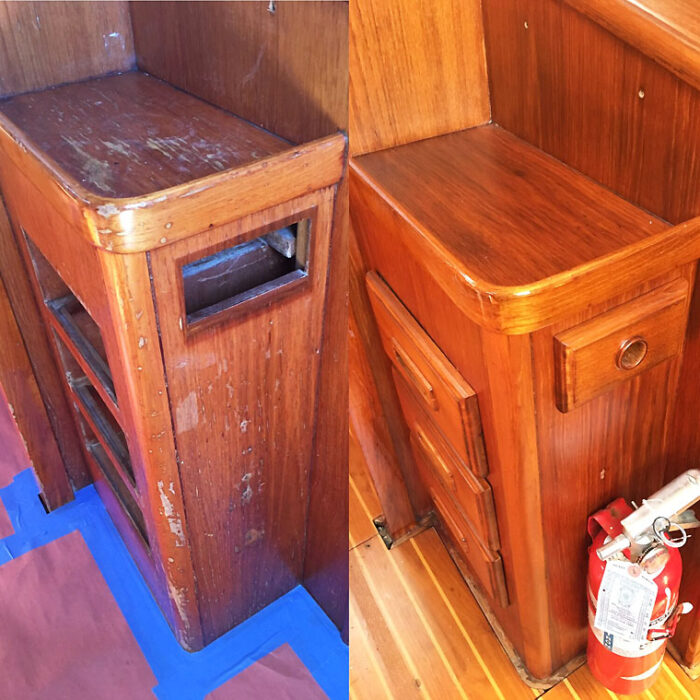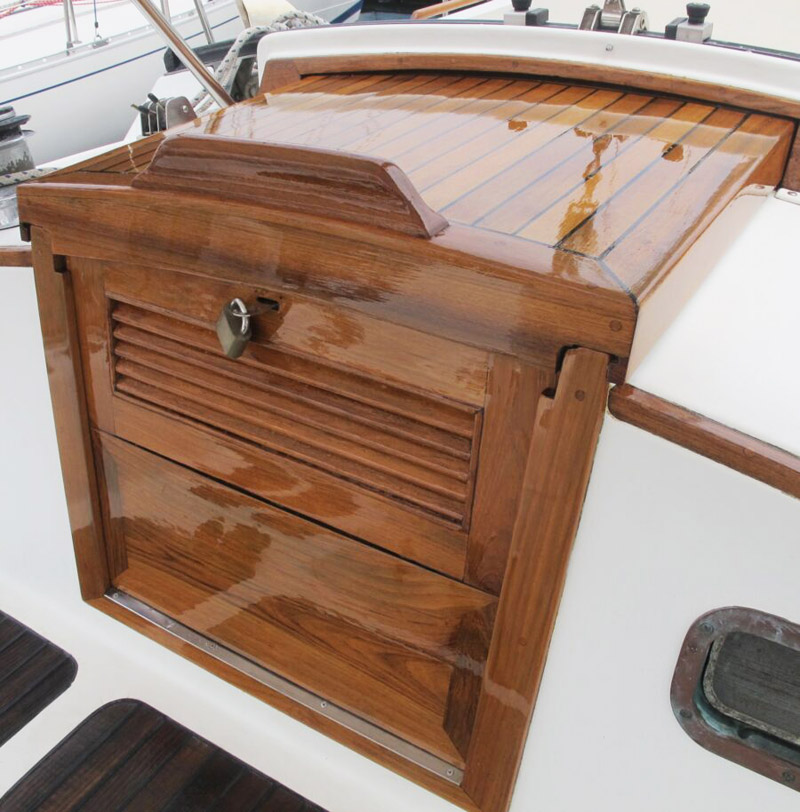Want to learn how to select boat varnisher for your boat? Is your boat in need of a little care on its brightwork or wood finish? Will you engage help from a tradesman or local boatyard? Or will you tackle it yourself?
If you’re feeling stymied by the process or don’t know how to start, Nathan Stone of Moana Brightwork in Oakland, California has some suggestions.
Nathan began his maritime career in Key West, starting as a deckhand on traditional schooners. Heeding a penchant to travel on the water, he eventually joined a wooden square rigger that was sailing throughout the South Pacific. After a year of extended offshore cruising and island hopping he returned to Florida to obtain his USCG 100 ton captain’s license and work for a shipwright. Nathan relocated to Newport, Rhode Island, to race on wooden America’s Cup 12 metres boats, and at the completion of sailing season he landed his first placement on a classic 72′ wooden private yacht where he learned what perfection in varnish can be. Over the next five years he toiled as chief mate on various private sailing yachts up to 108′. In 2013 he opened a shop in Oakland, California.

The Glory of Boat Varnishing
Glossy magazine photos give us romantic ideas about owning a boat with lots of brightwork, but the reality is constant maintenance. As you walk the docks, you’ll find more boats with varnish peeling and flaking off than there are with great varnish jobs. That’s because it takes a lot to maintain it. Some owners want the most spectacular show boat on the dock, others are happy to get out on the water to sail as much as possible and could care less about how much brightwork they have or how it looks.
The bottom line is that everyone has a different budget, and different expectation of how they want their boat to look. I can offer a million more thoughts on the topic. Thing is, there are a lot of opinions on how to do the work. How do I select boat varnisher? The more knowledge a boat owner has, the better.
Read about classic wooden boats that love varnish.
Select boat varnisher for my old wooden boat
Many marinas and local chandleries have bulletin boards where local tradesman leave business cards. Some maintain a list of contractors, and you may be able to ferret out recommendations. Ask owners in the marina too. Find the boats with the best wooden brightwork and inquire who did the job. See a boat varnisher on the docks? Strike up a conversation. If you’re hunting for help, that conversation may give insight into the person’s level of skills and personality.
You may also walk away with an estimate for boat varnish work. I tend to land a lot of work by being out on the docks. Varnish projects usually take a while to complete, so there is plenty of time to meet and talk with people on neighboring boats.
When comparing the price of a tradesman versus a boatyard, the latter generally costs much more due to higher cost of overhead. Quality wise, things will likely be the same. Some boatyards have old wooden boat varnishers on staff; some don’t specialize in that service. Ask around. Ask for DIY tips about how to select best varnisher before you hire.
Looking for tips to select boat varnisher for classic wooden boat? Moana Brightwork in Oakland has restored many San Francisco and other regions classic wooden yachts.
Best Questions to Ask a Marine Boat Varnisher
1. For how long has the craftsman been varnishing? How frequently does he/she varnish?
Many tradesmen don’t specialize in varnish work; they provide a wide range of marine services. Is this important to you? Some boat owners prefer working with a specialist, others are not as concerned about engaging a generalist.
2. How does the boat handyman person charge: by hour or completed project?
3. Can I get a detailed estimate of boat varnish job in advance?
An estimate is great not only for record keeping, but also reveals the yacht tradesman’s understanding of process. The more the sailing craftsman can show or tell about the work to be done, the more it likely shows level of experience. More detail in an estimate may also allude to how well the finished product will be.
4. Can I see examples of boat wood varnish work?
Varnishers take a lot of pride in what they do and like to show it off. My phone is filled with finished job boat varnish pictures. If you are talking with a craftsman at the docks, often times there will be other boats in the marina that he has worked on. Photos are great to reference, but there’s no substitute for examining the real thing.
5. Can I do part or the entire wooden varnish job?
Of course! It isn’t rocket science. It is just a lot of hard and tedious work. Your first effort may not look like a professional job, but getting the wood sealed and protected is the number one goal of protective wood opn sailboat varnishing; aesthetics are a very close second though. Some marine varnishers don’t mind being hired to only do the stripping and removal of the old finish; some prefer to do all the work. It never hurts to ask.
6. Does my varnish/brightwork need to be stripped to bare wood and built back up, or will maintenance coats be enough?
Good quality marine varnishes such as Epifanes and Flagship contain UV blockers, but unfortunately these eventually break down and permit harmful rays to penetrate to base layers. If the boat’s wood has been well protected, it may only require sanding plus three maintenance layers of varnish. Varnish protects the wood and helps prevent yellowing from UV exposure.
If your boat has blisters and bleached exposed spots of wood, the recommended option is to strip the wood and start again. A boat with lots of bare patches will usually look very spotty and discolored when just a maintenance coat is applied. The addition of more maintenance varnish coats will only make things look bad and that much more glossy.
7. What are the Steps of a Bare Boat Process?
A boat that needs to be taken to the bare wood is much more work—one reason why it’s so important to stay on top of varnish maintenance. A bare wood project involves completely removing the old finish with a heat gun and scraper (sometimes chemical stripper), sanding the bare teak to remove ALL of the old finish, then at least 10 coats of varnish.
8. When should I tackle an old boat varnish job?
Varnishing in the winter can take longer due to moisture from rain, and cooler temps make varnish dry slower. On the flipside, a varnish job done during the summer can stretch into more time than anticipated if an owner frequently takes out the boat. Also take into account the number of tradesman on the job; some have helpers, some do it alone. Also ask how many concurrent projects the person will be managing.
9. What type(s) of product will you use on my boat?
Most marine craftsmen prefer one type of varnish over another, and each has its pros and cons. For traditional varnish, I prefer Epifanes. I find that it gives the deepest shine and gloss, the most UV protection and it lasts longer between maintenance coats. There are many different finish options. A varnisher should know the pros and cons of several, and should be able to recommend the right product for the boat, owner and budget.
10. How often do I need a varnish job?
How often a varnish job needs to be done depends on the amount of sun exposure. Most traditional varnish jobs benefit from a new maintenance coats every ten months or so; some of the newer synthetic products last longer. When doing a varnish job, this is also a good time to tend scratches and cracks. Fill these areas to prevent moisture from getting underneath the base coat; moisture which can damage the varnish-to-wood bond.
11. Are their regional differences or techniques?
There are not many differences in techniques in the Bay Area, as opposed to other areas. We are fortunate to have moderate temps throughout the year, so we can varnish year round. Rain is certainly a factor though, and can easily extend a project’s length.
12. What should I anticipate for cost?
Varnish projects vary greatly in cost and process. Some boats have tiny bits of teak trim, some are loaded with brightwork. Most varnishers charge between $25 and $60/hour. Boat yards can charge more than $100/hour in the San Francisco area. A deposit of 25 to 50% of the estimated cost is common.


